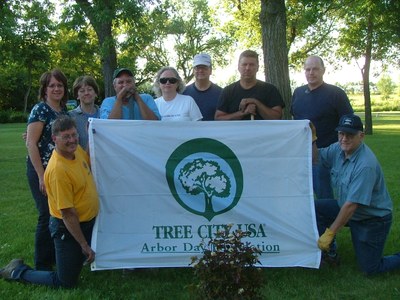2014
The Beauty of Mulch
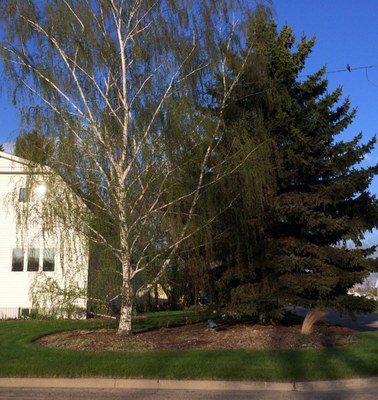 A wood chip mulch is one of the nicest things you can do for your landscape trees and shrubs.
A wood chip mulch is one of the nicest things you can do for your landscape trees and shrubs.
In America, grass and trees tend to be planted together, with grass growing right up to the tree trunk. This manicured lawn is a look that we have come to accept as normal yet in reality, grass and trees are incompatible and adversely affect one another.
Trees and grass compete for precious soil moisture in North Dakota. Both become stressed and this leads to reduced growth, diseases and increased susceptibility to pests for both species. Weeds with low moisture requirements can easily become established in this situation and perhaps lead a homeowner to apply additional pesticides. In addition, both grass and trees produce compounds that inhibit each other’s growth; this is called allelopathy and is best known to homeowners with black walnut trees.
Weed-free, clear soil seems to be popular here. While the trees grow better than when planted with grass, it is still not ideal. Wind strips moisture from the bare soil, tillage breaks the tree’s feeder roots which reside in the uppermost soil, and broadleaf weed herbicides can sometimes lead to permanent tree damage (they are also broad-leaved plants). In a forest, trees create their own mulch with fallen leaves which helps retain soil moisture, moderates soil temperature and increases the organic matter in the soil as the mulch decays. In your yard, woodchip or leaf mulch works the same way and also creates a buffer to keep the mower and weed-whipper away from the trunk.
In the Sustainable Urban Landscape Information Series from the University of Minnesota, there is a wonderful article on this subject: “Trees and Turf: Are They Compatible?” In it, “a field study at the Morton Arboretum in Lisle, Illinois, showed that after only two months, elimination of grass around 20-year old trees resulted in a 113% increase in fine root density in sugar maples, and increases of over 30% in green ash and littleleaf lindens. Root density increased even more when an organic mulch cover was applied.” Roots feed your trees; if they increase, your tree will have a better life.
Alright, start mulching. Happy, healthy trees and fewer weeds – that’s beautiful!
http://www.sustland.umn.edu/implement/trees_turf.html
http://ohioline.osu.edu/b894/pdf/b894.pdf
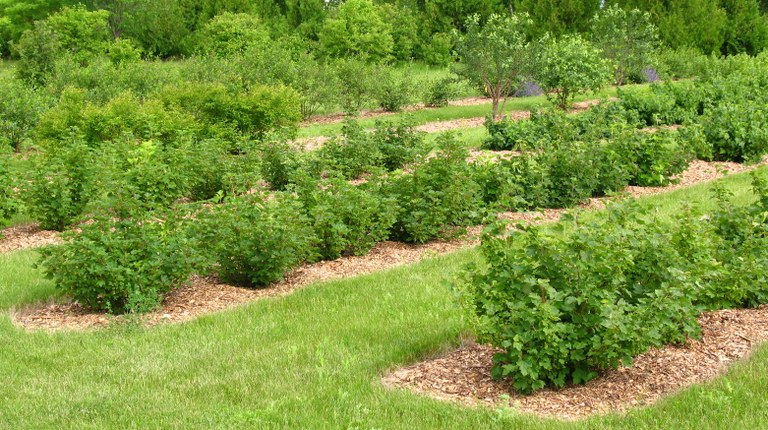
Mulch conserves water and reduces weeding in the CREC Fruit project.
Kathy Wiederholt
Fruit Project Manager
Foundation Seedstocks at the CREC
One of the major programs of the CREC is the Foundation Seedstocks program. This program is an integral part of the broader NDSU Foundation Seedstocks Project at the North Dakota Agricultural Experiment Station (NDAES).
The overall project operates under the leadership of the Foundation Seedstocks director who is based at the Main Campus in Fargo. The project includes individual seed increase programs operating at the Agronomy Seed Farm in Casselton and at the Research Extension Centers at Carrington, Langdon, Minot and Williston. Production and conditioning of foundation seed at these multiple locations maximizes our potential to introduce improved crop genetics to farmers, expands the diversity and number of varieties we increase, and minimizes chances of crop failure. The CREC’s foundation seedstock program typically produces and conditions 15 to 26 varieties among seven different crops annually.
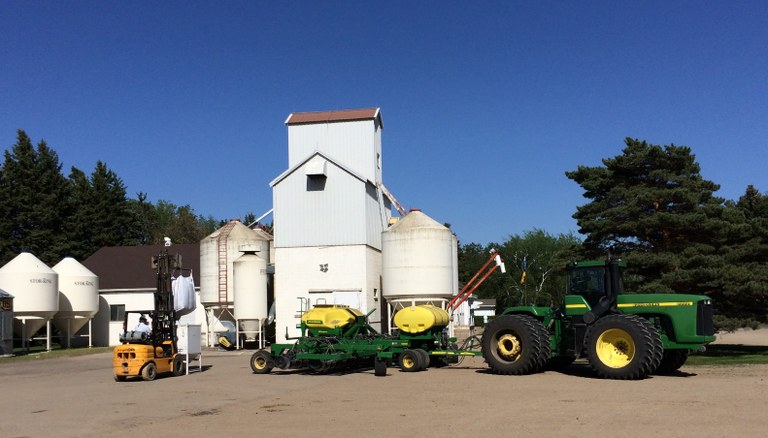
The foundation seedstocks project is responsible for providing foundation grade seed to seedstock growers across the state and region. These growers represent both individual producers and seedsman who have established seed businesses serving other growers. Foundation grade seed represents seed of the highest purity standards and is the progeny of breeder grade seed or seed that has been maintained from early generation propagation. Seedsman who plant foundation grade seed are then eligible to produce registered and/or certified classes of seed. The NDSU Foundation Seedstocks Project primarily produces foundation seed of crop varieties developed by NDSU plant breeders. New varieties are released by the NDAES after they have been shown to possess improved traits beyond those of current varieties. When a new variety is released the plant breeder turns over the available breeder seed to the seedstocks program for propagation and multiplication. This process starts with a limited amount of seed, typically around 3 to 5 bushels. Through aggressive increase strategies the team of increase programs manages this seed under strict production guidelines so that initial release of the seed to the public occurs as soon as possible. For most crops and varieties the goal is to have at least 2,000 to 5,000 bushels of seed for initial distribution. The primary means of initial distribution is providing the foundation seed to participating counties of the North Dakota Crop Improvement & Seed Association.
Attaining the quality and purity standards required to produce, condition and achieve a class of certified seed requires an increased management level for one’s land, equipment and facilities. The production of any class of seed (foundation, registered, or certified) requires field inspection and laboratory testing by the North Dakota State Seed Department (NDSSD). An important part of producing certified seed is the field inspection process. To have fields inspected growers must submit field inspection applications to the NDSSD. Application forms may be obtained at a county Extension office or directly from the NDSSD at http://www.nd.gov/seed/forms/ndseedform.pdf. Field inspection applications are due June 15 for all crops except conventional soybean, buckwheat and millet.
Dave Copenhaver
Foundation Seedstocks Research Spec.
Is sulfur deficiency in spring wheat a concern in North Dakota?
Sulfur (S) is vital for wheat grain yield and quality but is not needed in high amounts as in alfalfa and canola. Higher yielding crops will require more S.
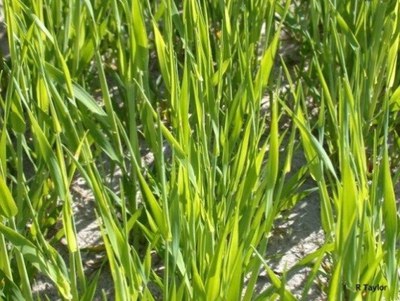
Deficiency symptoms: Young leaves and sometimes whole plants are light green to yellow because S is immobile and is not transferred from older to younger leaves (Figure 1. S deficiency in wheat; photo courtesy: R. Taylor); retarded and stunted growth with spindly stalks.
Conditions that may cause S deficiency: Wheat is more likely to respond to S fertilizer in coarse texture soils with low SOM (<3%) content and on eroded soils. Sulfur deficiency is likely in cooler than normal spring temperatures especially on no-till fields. Poor drainage and ponded soil reduce conversion of organic S (the main source of soil S) to the available sulfate form. High fall and spring precipitation can cause leaching of available S below root depths.
Is it economical to apply S to wheat? More often than not, S application has improved yields significantly in sandy soils but limited economic benefits in non-sandy soils. Mineralization of S from adequate SOM levels and high gypsum in North Dakota soils often meet plant needs. Between 20 and 30 lbs. of S is adequate to meet wheat S demands. Extensive research shows that wheat yields and grain quality improve when S is applied in non-limiting soil N. Nitrogen use efficiency increases with adequate S. When in doubt, apply an insurance rate of about 10 lbs. of readily available S as ammonium sulfate (21-0-0-24S). Sulfur deficiency would hurt grain yields significantly. In a Carrington N study, S deficiency was partly responsible for lack of yield response to N rates (with yield decline) at N > 60lbs (Figure 2).
Reliability of S soil test: Soil S test is not a reliable predictor of wheat response but may help indicate soil S status. Plant tissue analysis is a useful tool to detect S problems. Sample leaves from suspected areas in the field and from more vigorous looking plants. Send plant samples to the NDSU laboratory for N and S analysis. The tissue N:S ratio is an important indicator of S needs by wheat. Tissue N:S ratio > 16 - 20 may suggest insufficient plant S. Sulfur analysis alone may not give you all the information needed to determine S fertilizer needs. At time of plant sampling, collect a composite soil sample from respective plant sampling areas for S analysis.
Jasper M. Teboh
Soil Scientist
May Is Arbor Month in North Dakota
Arbor Day celebrations began more than 140 years ago.
In 1872, J. Sterling Morton proposed “to set aside one day to plant trees, both forest and fruit.” As the editor of Nebraska’s first newspaper, Morton spread his enthusiasm for trees to a receptive audience – more than one million trees were planted in Nebraska on that first Arbor Day.
The Lions Club of New Rockford completed a tree planting project in the park in 2012.
The tradition has spread, and all fifty states have an official State Arbor Day. In North Dakota, it’s the first Friday in May. In fact, the entire month of May is designated as Arbor Month. But don’t let a calendar dictate when you plant a tree! A containerized tree from a nursery can be planted anytime during the growing season – just be sure to plant it correctly, give it plenty of space to grow to mature size, and water every week or so for the first year of establishment. Diversity is the best defense against invasive pests like Emerald Ash borer, which targets all species of ash. Recent street tree inventories conducted by the ND Forest Service reveal that over 40% of our street trees are ash. It’s time to plant something different. Go out on a limb and plant a Prairie Expedition American elm, Prairie Torch buckeye, or Northern Acclaim honeylocust – just a few of the introductions released through NDSU’s Woody Plant Improvement Program.
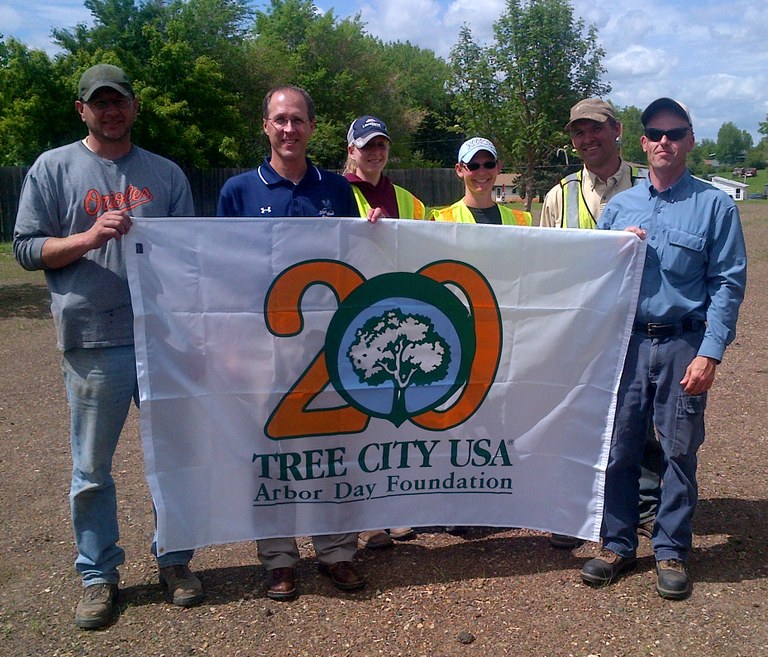
North Dakota is home to 48 Tree City USA communities. Holding an annual Arbor Day celebration is one of the
requirements for achieving and maintaining status as a Tree City USA.
The 20-yr flag is held by Dickinson city forestry department - 2013.
Happy Arbor Month!
Gerri Makay
Community Forestry Program Manager
ND Forest Service
Gerri's office is located at the CREC.
Aggressive Plants
There are not a lot of tractors rolling in the field yet, but there are aggressive plants trying to take advantage of the plentiful moisture.
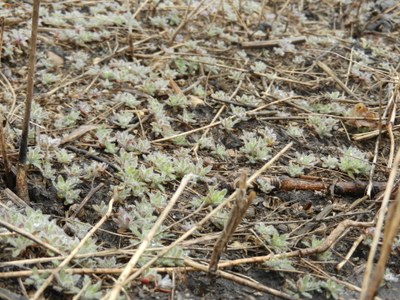
This kochia was seen growing in flax stubble at the Carrington Research Extension Center.
Fortunately, we were able to put out a few herbicide treatments on October 29, 2013 as shown in the following photo.

For no-till producers, this year represents a good example of when fall applied herbicides would provide a level of protection until the field is ready for crop production. If the kochia gets much larger than what’s pictured, many herbicides and light tillage will not provide complete control of the kochia.
Even though our field season is just starting, or soon to start, weeds are well ahead of the game.
Mike Ostlie
Agronomist
Manure Fertilizer Use Recommendations
The NDSU Carrington Research Extension Center conducted a research program to determine if manure can supply the necessary nutrients for typical crops grown in the upper Great Plains.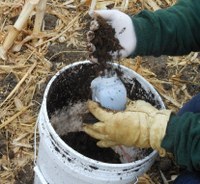
Manure contains all the nutrients necessary for plant growth but these nutrients are primarily in the organic form, which is not readily available for plants. Microorganisms naturally present in the soil break down the manure and during that process nutrients are more slowly made available for plant growth compared to commercial (inorganic) fertilizer. The rate at which the nutrients are made available through this process will vary depending on soil conditions and what species of animal the manure came from.
Corn, canola, and hard red spring wheat were used in the research trials. Five trials using spring wheat were conducted to compare the effect of manure application (fall- and spring-applied) versus commercial fertilizer. Two additional studies for each canola and corn compared spring applied manure with commercial fertilizer. Plots with no fertilizer were the control treatment for all the trials.
- Corn yields did not vary significantly when commercial fertilizer vs. spring-applied manure were compared.
- Canola yields were significantly lower when spring-applied manure was compared with commercial fertilizer. The release of N from spring-applied manure is too slow for this high demand crop.
- Fall-applied manure vs. commercial fertilizer were statistically similar for the spring wheat trials.
Following are some recommendations for using manure as a fertilizer source.
- Sample the manure that is going to be used to determine the nutrient content. Information about manure sampling labs can be found by going to: www.ag.ndsu.edu/lem/resources/manure-nutrient-sampling-and-testing.
- Credit 50% of the total N in the manure analysis as available the first year of application.
- Manure nutrients are a complete substitution for commercial fertilizer for corn production and can be applied in the spring or fall.
- Short-season crops, such as spring wheat and canola, will have a high N-demand at the beginning of the growing season and require 20 to 40 pounds per acre supplemental commercial N fertilizer if manure is spring-applied. The same recommendation may be beneficial for fall-applied manure as well.
Livestock manure can be used as a sole fertilizer for select crops grown by North Dakota producers. More information on this study, including data, can be found by going to: www.tinyurl.com/NDManureFertilizer.
Mary Berg
Area Specialist
Livestock Environmental Management
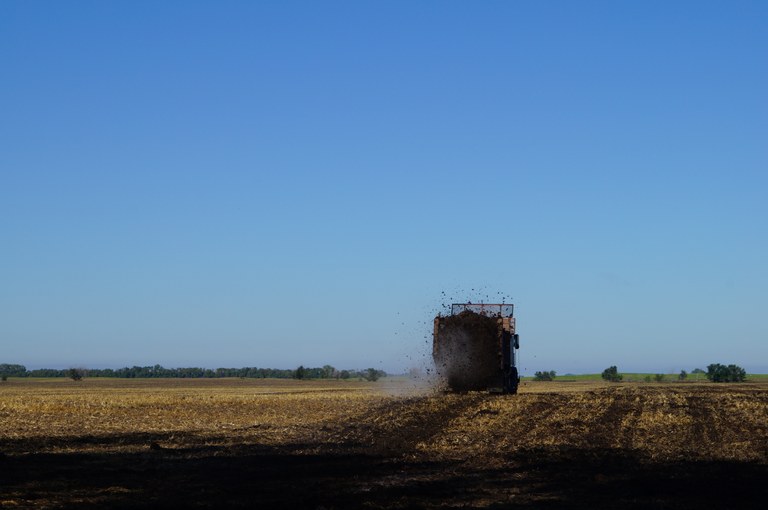
Aerial Precision Agricultural at the CREC
As most of you have probably heard or read in the newspaper, the CREC will be the host site for a first-of-its-kind project this summer.
North Dakota State University has partnered with the John D. Odegard School of Aerospace Sciences at the University of North Dakota to conduct a proof-of-concept project that will evaluate the usefulness of Unmanned Aerial Systems (UAS) systems in precision agriculture. The CREC is located within the Northern Plains Unmanned Aerial Systems Test Site which required approvals from the Federal Aviation Administration (FAA). The project is being led by John Nowatzki of NDSU’s Department of Agricultural and Biosystems Engineering.

Photo courtesy: www.dragonfly.com. This is an example of the UAS system we will use this summer at the CREC.
Though it is unclear as to the exact quality of data that will be collected, previous work in UAS has produced extremely useful results in regards to applying crop scouting techniques from the air. The CREC has provided the project a very unique opportunity as we evaluate many different types of crops and crop management techniques throughout the growing season, as well as provide an area for evaluating the UAS in livestock management. Some examples of information that we hope to collect will be plant populations, weed infestations, crop diseases, and many other factors that influence a producers management decisions throughout the year. Though it is currently a one year project we hope to extend the evaluation of UAS here at the CREC in to the future.
Stay tuned for upcoming events that will demonstrate the use of the UAS aircraft and highlight the specific areas of agriculture we will be able to look at. For more information please contact the CREC at (701) 652-2951 or email Justin Berg, Agronomy Research Specialist, at justin.t.berg@ndsu.edu.
Calf Feed-out Program - North Dakota Angus University
The North Dakota Angus Association is again partnering with the NDSU Carrington Research Extension Center (CREC) in sponsoring the third annual North Dakota Angus University (NDAU) calf feed-out program.
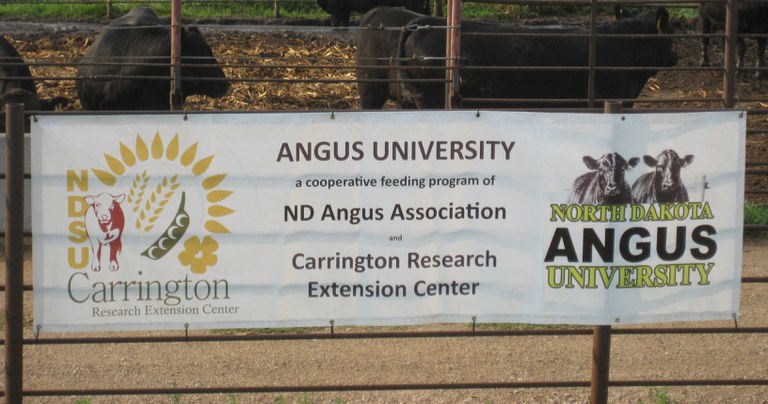
In the summer and fall of 2013, the second NDAU project was held with great success. One hundred and eighty two head of yearling and fall steer calves where consigned in the feedout program at the CREC. In addition to the valuable information producers received regarding the feedlot performance of their cattle; the steers were used in a feedlot research trial. No treatments were imposed that would reduce performance of the animals. In the 2013 feedout program, cattle gained an average of 4.6 lbs per head per day, had a feed efficiency of 6.50 pounds of feed intake (dry matter) per pound of live weight gain, had a dressing percentage of 62.91%, with 87% grading choice or better.
If you are interested in gaining a better understanding of how your Angus sired cattle perform in the feedlot, their quality grade and the potential profitability available through retained ownership; Angus University would be a viable option for steers from your operation. Participants in NDAU will receive periodic progress reports on their calves’ performance as well as a final report on the overall performance, efficiency, and carcass traits for their calves.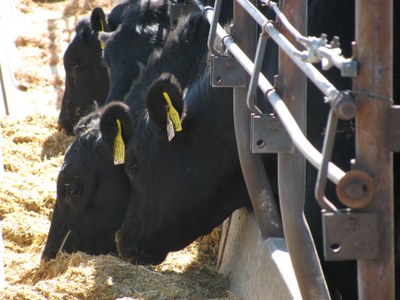
Mike Wendel from LaMoure, ND, has consigned cattle both years of the program and has been happy with his calves results in the NDAU trials. Mike has been able to use information generated from the program as a benchmark comparison in his own herd. “Not only did we get the carcass data back from the cattle we had at the University, but we also did a carcass and profit comparison to the calves we had there against the calves we kept at home,” says Wendel. “I think that was a huge bonus for us. We compared our rate of gain and carcass performance. It was a nice, unbiased comparison, and the whole process has been very educational.”
The NDSU Carrington Research Extension Center requests that animal consignments be between 800 and 900 pounds and in multiples of four from each individual producer. If you are interested in participating or have questions, contact Chanda Engel, M.S. at the CREC at (701) 652-2951 or email chanda.engel@ndsu.edu.
Soybean Plant Establishment Factors
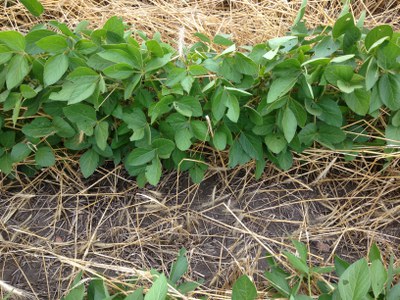
NDSU has conducted soybean production management trials that have included numerous plant establishment factors. The data from 1999 to 2013 trials has been compiled as a quick reference for farmers and crop advisers.
The following is the current (April 2014) listing of yield comparisons by percentage (%) for selected establishment factors (numbers in parenthesis at end of each statement indicate number of trial site-years):
- Yield with reduced-till systems (no-till, strip till and direct seeded) was 7% > conventional tillage (19).
- Soybean following wheat yielded 7% > soybean as prior crop (6).
- Early planted soybean (last week in April through first week in May) yield was 13% > mid-May planted soybean (4).
- Planting rates of 150,000 to 175,000 pure live seeds (pls)/acre yielded 5% > planting rates of 100,000 to 130,000 pls/acre (21).
- Yield with intermediate row spacing (14 to 21 inches) was 6% > wide rows (28 to 30 inches) (20).
- Use of fungicide-treated seed provided yield 5% > untreated seed (28).
- Weed control starting when soybean are planted provided yield 4% > post-emergence weed control initiated when weeds were 2- to 4-inches tall (5).
Consider using the ‘underlined’ factors to increase soybean yield potential in 2014.
Greg Endres
Area Specialist, Cropping Systems
It’s Time to Prune Your Fruit Trees!
Pruning opens up a tree so that more light and air gets around all of the fruit and leaves. You can also manage the height and shape of the tree. Pruning is best done while the tree is dormant – before buds swell.
Here’s what pruning helps: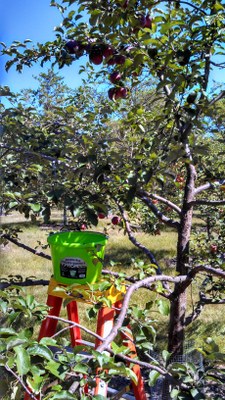
- Reduces the chance of fungal problems by allowing more air to move in the leaves.
- If you need to spray your tree, it will be easier to get the product applied.
- It will reduce the tree’s crop load, making the tree more likely to bear fruit every year.
- The fruit will be bigger and ripen faster.
- When fruit is picked earlier, the tree has more time to prepare for the coming winter.
Use a sharp, quality hand pruner, lopper or pruning saw. Disinfect them between trees or between diseased areas of a tree. Remove branches that point downward, inward, straight up (water sprouts) cross over/through the tree, or will shade the branch below. Clean out small twigs near the center of the tree. Keep branches that are growing outward and upward and look healthy. Just start in one place, removing the obvious stuff, and go from there. Don’t be afraid- you can always fix mistakes next year!
Links:
http://www.ag.ndsu.edu/pubs/plantsci/hortcrop/h327.pdf
http://www.mlive.com/weather/index.ssf/2013/03/there_is_still_time_to_prune_f.html
http://learningstore.uwex.edu/assets/pdfs/A1959.pdf
Disinfecting your tools:
http://ucce.ucdavis.edu/files/repositoryfiles/ca4504p21-69554.pdf
Kathy Wiederholt
Fruit Project Manager
Welcome
Welcome to Center Points!
Today we initiate a new feature on the NDSU CREC home page designed to provide another means for our constituents to learn about program activities and project progress. Center Points will be updated weekly by the Carrington Research Extension Center staff who will share thoughts and observations derived from their program activities. These updates may simply be a sharing of crop development notes, review of weather influenced issues, interesting research treatment responses or a more in depth discussion of specific research projects. The CREC is one of eight out-state Research Extension Centers of North Dakota State University. As a department, the CREC represents both the NDSU Agricultural Experiment Station (AES) and the NDSU Extension Service (EXT). The majority of the CREC’s programs and activities are associated with conducting research which represents the mission of the Agricultural Experiment Station. In 1986 the CREC became the first out-state Research Extension Center of NDSU when Extension Service specialists were co-located with researchers in one facility. The CREC’s program of education or extension represents the mission of the Extension Service. Together the AES and EXT staffs of the CREC work to enhance the productivity, competitiveness and diversity of agriculture in central North Dakota and the state as a whole. Through our programs we work to address issues that present near and long-term challenges to the viability of farm and ranch enterprises. The hope and expectation is that these viable agricultural enterprises will help sustain vibrant rural communities and the natural resources that are the basis of agriculture’s potential.
In the weeks ahead, I invite you to check Center Points for updates that will share observations from across the diverse program areas of the CREC. Anticipate briefs related to crops and soils, animal science, nutrient management, fruits and berries, foundation seedstocks along with details related to upcoming tours and workshops. We will also share program updates from the Farm Business Management Education and North Dakota Forest Service programs that have staff based at the CREC.
We look forward to utilizing Center Points as a means to broaden our constituencies’ knowledge of CREC program activities. Thank you for reading and on behalf of the team at the CREC we thank you for your support in helping to position the CREC to serve you now and into the future.
Blaine Schatz
Director & Agronomist


